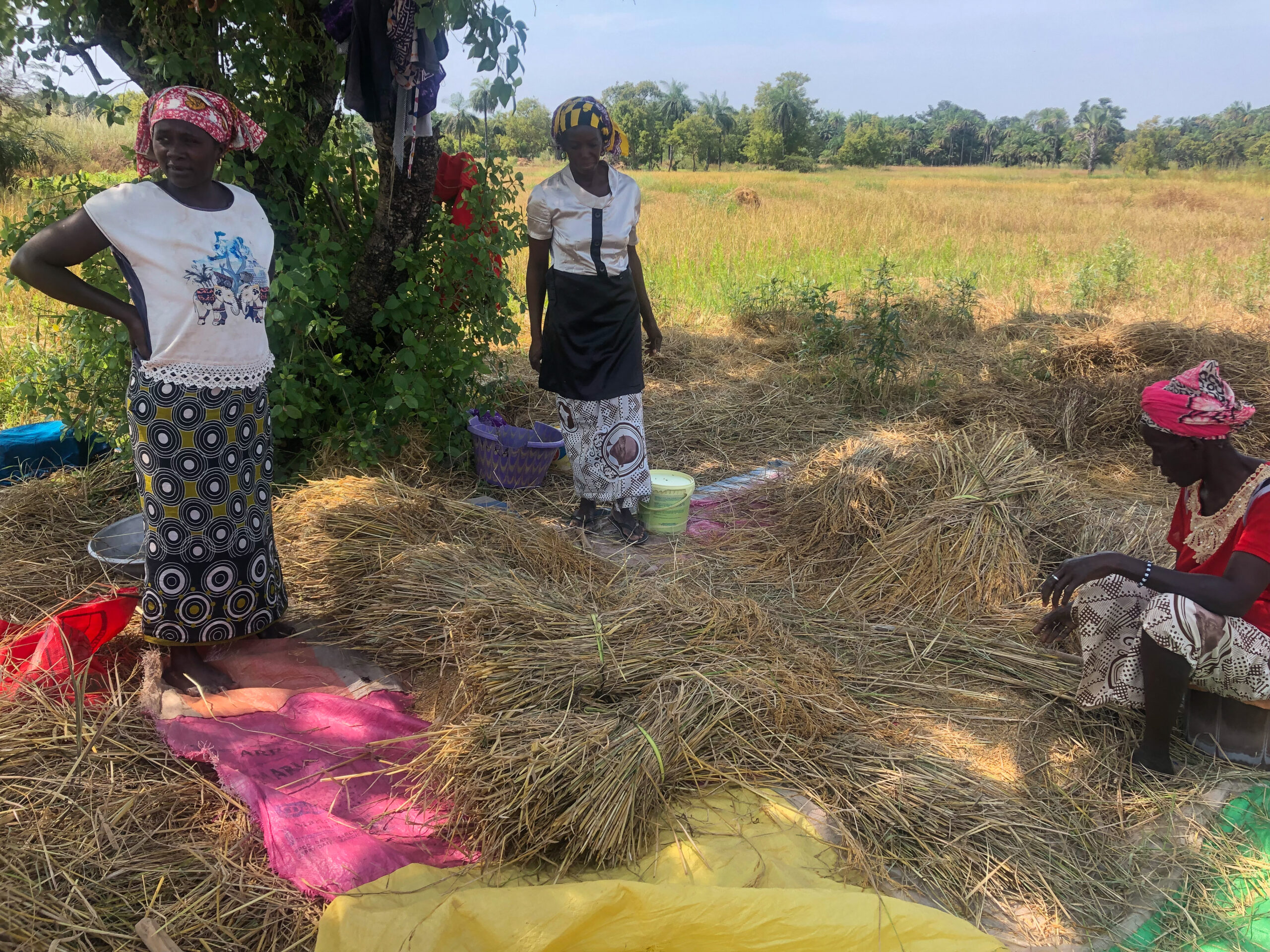
Photo: Women in the agricultural areas in Casamance, Senegal
Climate-driven environmental challenges and peacebuilding meet in southern Senegal. Two CGIAR Climate Resilience Initiative scientists discuss the challenges faced by – and next steps for – people reclaiming ancestral land that was scarred by conflict – and changed by the climate.
By Alexandra Krendelsberger (Wageningen University and Research; The Alliance of Bioversity and CIAT), Carolina Sarzana (The Alliance of Bioversity and CIAT)
Close to the border of Guinea Bissau, two small villages recently started resettling efforts after having left their homes abandoned for more than 30 years. The villages of Bissine and Singhere were among the strongest affected by the separatist Movement of Democratic Forces of Casamance in southern Senegal in the 1990s. Severe security issues remained until 2021 when de-mining activities by Humanity & Inclusion, an NGO, and the government made the zone safe for resettlement.
Since 2020, villagers in both locations have slowly been returning to their ancestors’ lands, where they found their houses and fields taken over by the native tropical vegetation. Left without any shelter or cleared land, the villagers have been struggling to create basic living conditions including housing, water access points, electricity and communal gardens. The provision of these basic infrastructure needs is fully thanks to the contributions Humanity & Inclusion, which is still active in the area, even after the de-mining was completed. Now it seeks to support revitalizing the communities for humans and nature. Another NGO, the Centre for Humanitarian Dialogue, has been intervening in mediation and building social cohesion to sustain peace and security.
Most of the livelihood activities before displacement circulated around agricultural production and the selling of the produce. The main crops grown were rice, ground nuts, corn, beans and vegetables. Now production has shifted towards watermelon, rice and groundnut. Although current production is heavily focused on cash crops, the villagers are unable to harvest and sell enough to sell at nearby markets to make a decent living.
The lack of revenue is, firstly, because not enough land has been cleared to provide for greater production capacity. The preparation of agricultural land is a tedious process, as authorities for water and forests (Eaux et Forêts) need to provide approval for the clearing of lands as Bissine is directly located on the outskirts of a national forest (the Forest of Bissine, or Forêt de Bissine).

The authors visit a former rice field that is now salinized land
Climate shocks and changing environmental conditions are contributing to challenges in generating revenue. This year, heavy off-season rains fully destroyed the watermelon harvest and left the fruits decomposing in the fields. A slower onset environmental event is salt intrusion from the river Casamance in rice paddies, which damages harvests and leaves land unusable for agriculture. Both impacts are predicted to affect livelihoods even more with increasing climate variability and sea-level rise.
The need for climate adaptation to preserve and rebuild livelihoods and aid-funded resettlement is crucial, especially at these early stages. Collective action among community members has been quite successful at restarting lost livelihoods and creating suitable living conditions. The focus is now on what can be provided to sustain peace and overcome climatic and environmental challenges through the continuation of strong and collective action.
Humanity & Inclusion has contributed crucially to demining the landscape and is looking for collaborations to provide programming based on four axes: adapted technical and infrastructural support, capacity building, project durability and local knowledge valuation. Infrastructural and technical assistance is critical at this early resettlement stage in the villages surrounding Ziguinchor to ensure communal stability, viability, and resilience. Apart from requiring support for building houses and clearing land, returnee communities will need useful infrastructure to establish decent living conditions and adapted productive systems.
Building capacities will be crucial in vulnerable returnee societies that need to rebuild their infrastructure and foodscapes from zero, and learn practices and techniques to adapt to the new challenges posed by climate change. It will be essential for these people to develop the capacities needed to better withstand climate impacts, including shocks and slow-onset climate effects. They will need training in collective landscape and territory management to face the risks related to growing resource scarcity (such as arable land loss due to salinization) and potentially mitigate resource-driven conflicts.

A rice harvest ruined by salty soils
A practical landscape management example, relevant to these villages, would be the establishment of fish livestock-raising areas. Additionally, if fisher communities were trained to manage spaces dedicated to fishing activities, the building of more dams on the Casamance river tributaries would be possible, which would thereafter prevent salt from further intruding in agricultural lands and from disadvantaging farmers.
A crucial aspect of context-sensitive climate action programming is ensuring durability. In this sense, frameworks must be put in place for the long-term sustainability of good environmental management for programs maintained by communities. Finally, local knowledge valuation will be critical in ensuring that all livelihood systems in the region, including farming, herding, arboriculture, horticulture and fishing, benefit from climate action programs and are not excluded. Elevating local culture and protecting these traditional systems is an adapted response allowing for social cohesion and the prevention of potential tensions.
CGIAR Climate Security has been advocating for approaches ensuring that climate responses are sensitive to the context in which they operate and supporting the design and implementation of adaptation interventions that address the root causes of vulnerability and conflict in parallel. Maladaptive responses to climate change further exacerbate marginalization and exclusion, which are commonly recognized drivers of conflicts. To foster conflict-sensitive programming in vulnerable returnee communities, there is an imminent need to assess the extent to which a post-conflict context limits the efficiency of resilience-building interventions by external support.



